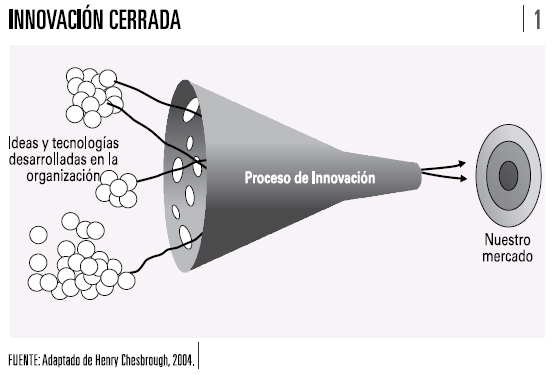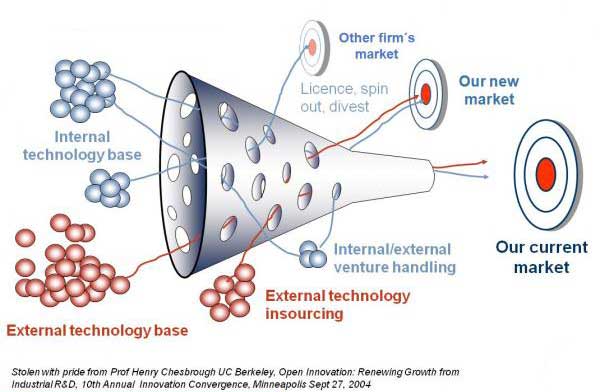Traditional innovation
Since the last century many companies with industrial designs maintained the knowledge through their monopolies; these firms led the industry thanks to their findings. Currently, these companies have been attacked by government antitrust policies, and by the avalanche of new and small companies (start-ups) arising from the growing quality and productivity of university research.
Perhaps the model of traditional innovation is an idea of wanting to keep everything under control, perhaps a way to protect an intellectual property and a classic model of obsolete monopoly, which is governed by inventions within the company. In these traditional models of innovation the goal is to have the best experts within the organization, so if we want to innovate in marketing we will necessarily need the best state or world experts working in the marketing department. The same would happen with technological, process and organizational innovation.
Traditional innovation processes are usually represented by a funnel, where ideas and technologies existing in the organization are introduced at one end and at the other extreme, the final product or service will be offered to the user. It is a linear system where it is necessary to select the best ideas, develop the prototypes, validate the prototype and the rest of the activities internally to finally obtain the desired result. The graph below shows this type of traditional and linear innovation process.

From the above, it could be deduced that if much more and better ideas are introduced at the end of the funnel, better products or services will be obtained, since we could think that the experts of the organization have done a good job identifying possible product or service ideas . However, today it is not recommended for companies to only work with a closed or traditional process, but they must incorporate open innovation.
What is the model of open innovation?
Henry Chesbrough is an economist and professor at the University of California (Berkeley), and considered the father of the term "open innovation". His proposal is that companies can make use of external resources and market best practices to add value to their own products or services, obtaining a better return on investment.
In this sense, the main objective of the organizations is to look for the most successful ideas, it doesn't matter if these have been generated by a group of young people in Silicon Valley, a team of researchers in Costa Rica, an online community of users in Croatia or the group of experts of the organization.

As you can see in the previous graphic, ideas and technologies do not only come from within the organization but also come from outside. Unlike the traditional model, there is no single exit but the process of innovation allows to exit the process before it reaches the traditional market. These outputs can be in the form of spin-offs, or patent licenses. This image reflects the great difference between the traditional model and the open innovation model, which is suggested today. Where organizations, from agri-food to aerospace have explored the search for brilliant ideas for many years through partnerships with universities, external R & D laboratories and technology start-ups.
On the other hand; According to the ATKearney report (2013), there is no company large enough or innovative enough to be a leader in innovation without collaborating with partners. In this sense, organizations that have the best practices in innovation produce about half of their innovations of ideas generated outside their company. Organizations that adopt open innovation can obtain ideas from different sources, understanding that each of the contributors offers a different and valuable perspective. They also point out in their report that they are organizations that work with a much more extensive network of partners and collaborate both upwards and downwards in their value chain. This study reveals that organizations have traditionally attached great importance to the first phases of the innovation process such as the generation of ideas, where creativity plays a decisive role. In this type of processes creativity and the generation of ideas also play a decisive role, but ideas are not only generated in the interior, but can be generated collaboratively between different organizations or can be imported from external organizations.
The transition from a closed innovation model to a more open one requires not only changes in the innovation process itself. The changes must be structural, from the organizational culture to the business model, through technologies, intellectual property management, etc.
Some successful cases of Open Innovation applied
An illustrative case is Google that in just 20 years have acquired between 200-300 projects, start-ups and companies to enhance their own development, being that the first of these occurred only 3 years after its founding.
Other successful cases is the company Techstars, which develops global entrepreneurship events under the wing of companies such as Ford, Amazon and General Electric. These companies determine the focus of the event and then benefit from accelerating the process of ideation and prototyping thanks to the projects that originate there.
Another representative case is that of Lucent and Cisco as direct competitors in a very complex technological sector. These companies do not innovate in the same way. Lucent in this case devoted great resources to explore the world of new materials, as well as components and systems of cutting-edge technology to find fundamental discoveries that would make possible the next generations of products and services. Cisco, on the other hand, explored the world of start-ups that were appearing everywhere and commercializing new products and services. Some of them, in turn, had been founded by veteran professionals from Lucent, AT & T or Nortel, who took the ideas with which they had worked in these companies and tried to create their own companies based on the same concepts. Cisco invested in some of them. Other times he just collaborated. And on more than one occasion he ended up acquiring some. In this way, it matched in R & D what was perhaps the organization with the most advanced industrial research in the world (Lucent) and without hardly investing in internal research.
Other success stories in the field are companies such as IBM, Intel, Phillips, Unilever and Procter & Gamble are examples of this open innovation model.

Why apply open innovation in organizations?
According to Chesbrough, collaboration in the development of products or services is one of the most important issues in open innovation models. Partnerships with third parties (partners) can create business models that reduce R & D budgets, increase innovation results and discover new markets.
According to the ATKearney report, open innovation allows organizations to reduce costs in innovation processes, causing the acceleration of innovation and the development of new products and services, thus increasing profits and market share and increasing the creativity of the company. own organization. It also allows reducing direct investment in internal R & D as part of that investment should be allocated to surveillance systems and collaboration with external agents.
All these benefits would not be possible without the change of the organizational culture since to implement an open innovation system, the NIH syndrome must be combated, that is, the "Not invented here" syndrome. This syndrome occurs when, due to pride, ignorance or something similar, it is decided to reinvent the wheel instead of using already available but alien knowledge. Collaboration is the key to open innovation.

In summary; open innovation is where entrepreneurs, companies, associations, government agents, among others, who are part of the ecosystem and will collaborate to build bridges and generate new opportunities and ideas, will synergize.
The objective will be to create connections between large clients and the entrepreneurial ecosystem to generate business and innovative solutions. According to this proposal, companies that want to survive the market must involve the Academy, Organizations and start-ups to navigate this new innovation route.
MAKE A COMMENT ABOUT THE TOPIC
